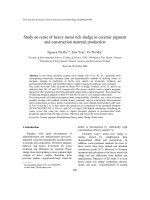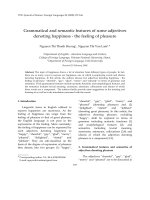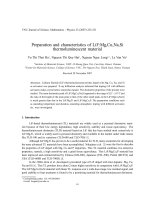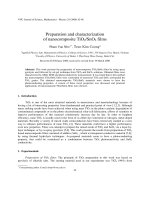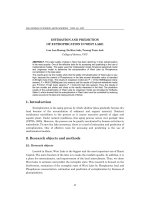Tài liệu Báo cáo " Estimation and prediction of eutrophication in West Lake" ppt
Bạn đang xem bản rút gọn của tài liệu. Xem và tải ngay bản đầy đủ của tài liệu tại đây (132.83 KB, 7 trang )
VNU JOURNAL OF SCIENCE, Earth sciences, T.xxIII, N
0
1, 2007
45
Estimation and prediction
of eutrophication in West Lake
Luu Lan Huong, Do Kim Anh, Truong Tuan Anh
College of Science, VNU
ABSTRACT. The water quality of lakes in Hanoi has been declining. In that, eutrophycation
is the most popular. One of the effective tools for its accessing and predicting is the use of
mathematical models. This paper used the Vollenweider model, Empirical watershed model
and Jorgensen model to determine the eutrophycation of West Lake by Phosphorous
concentration in the lake water.
The results given by the models show that the ability of Eutrophication of West Lake is very
high, because the content of Phosphorous in the lake exceed allowable value of standard
(0.03mg/l) many times. The results of Jorgensen model are: P = 13132-18894kg/year (rainy
season), P = 9450-23580kg/year (dry season) and the results of Empirical watershed model
are: P=0.45-1.71mg/l (rainy season), P = 0.64-2.45 mg/l (dry season). Thus, the results of
the two models are similar and close to the results measured in the field. The prediction
results of the eutrophication of West Lake by Jorgensen model are simulated by Software
Stella II, which showed that the eutrophication in West Lake could be controlled by reducing
waste sources to the lake and raising amount of fishes.
1. Introduction
Eutrophication is the aging process by which shallow lakes gradually become dry
land because of the accumulation of sediment and organic material. Nutrient
enrichment contributes to the process as it causes excessive growth of algae and
aquatic plant. Under natural conditions, this aging process occurs over geologic time
(CETIA, 2005). However, the process can be greatly accelerated by human activities in
watersheds. To save the lake ecosystem, there is a need of estimation and prediction of
eutrophication. One of effective tools for accessing and predicting is the use of
mathematical models.
2. Research objects and methods
2.1. Research objects
Located in Hanoi, West Lake is the biggest and the most important one of Hanoi
Capital. The main function of the lake is to make the rainfall equable. In addition, it is
a place for entertainment, and improvement of the local microclimate. Thus, we chose
West Lake to estimate and predict the eutrophic state. This research is focused on the
biodiversity, estimation of the eutrophic state of West Lake by Phosphorous load and
Phosphorous concentration, estimation and prediction of eutrophication by biomass of
phytoplankton.
Luu Lan Huong, Do Kim Anh, Truong Tuan Anh
VNU. Journal of Science, Earth Sciences, T.XXIII, N
0
1, 2007
46
2.2. Research methods
We used Vollenweider model to find the standard Phosphorous load, Empirical
model and Jorgensen model to estimate the annual Phosphorous loading into the lake;
CLEAN model (Hannon and Ruth, 1997) to analyze the change in phytoplankton
biomass. By using these models, it is possible to estimate and predict the
eutrophication of West Lake by both chemical parameters. The models are considered
with different cases and simulated by Software Stella II [6].
3. Results and discussion
3.1. Ecosystem of West Lake
The ecosystem of West Lake is rather diverse with 232 species of plant, 141
species of phytoplankton, 43 species of zooplankton, 11 species of benthos and about 33
species of fish.
According to Vietnam standard of water quality, the important parameters of
water quality of West Lake, including: Phosphorous and Nitrogen concentration, DO,
pH, are under not very good condition.
3.2. Estimating eutrophic state by chemical parameter (Phosphorous)
3.2.1. The standard amount of Phosphorous loading to the lake
We used Vollenweider model to calculate the standard amount of nutrients loading
to the lake. It is found that if the lake receives more than 1482kg of Phosphorous
(according to the condition of rainy season) or 786kg of Phosphorous (under condition of
dry season) per year, it will be eutrophic.
3.2.2. Estimating loads of Phosphorous
a. Estimating loads of Phosphorous by Empirical model
Phosphorous loading to West Lake is from 4 sources: soil, atmosphere, humans
and cattle. For each, there is an exporting coefficient, representing the average amount
of Phosphorous in every hectare of land for the lake per year. By using these
coefficients and data of West Lake, we found that West Lake would receive about P =
6020.4 - 22942.2kg/year in the condition of rainy season and 5789.4 - 22106.2kg/year in
the condition of dry season.
b. Estimating loads of Phosphorous by Jorgensen model
Jorgensen and Empirical models use the same method for estimating the amount
Estimation and prediction of eutrophication in West Lake
VNU. Journal of Science, Earth Sciences, T.XXIII, N
0
1, 2007
47
of nutrients loading to lakes. However, the exporting coefficients and the classification
of nutrient sources are different. There are three types of nutrient sources in Jorgensen
model: from soil, rain and humans. Thus, the results of the two models are different.
Results of Jorgensen model are: P = 13132 - 18894kg/year (rainy season) and P = 9450 -
23580kg/year (dry season).
3.2.3. Calculating Phosphorous concentration
We used Jorgensen, Empirical models and the results obtained from section
(3.2.2) to calculate the concentration of Phosphorous in the lake. According to
Empirical model, P concentration ranges between 0.45 - 1.71mg/l (rainy season) and
0.64 - 2.45mg/l (dry season). Similarly, according to Jorgensen model, P = 0.98 -
1.41mg/l (rainy season) and P = 1.05 - 2.62mg/l (dry season).
3.2.4. Estimating the eutrophic state of West Lake by Phosphorous parameters
There are two Phosphorous parameters: P load and P concentration. In this
research, we utilized both.
a. Estimating eutrophic state by P load
Table 1. Phosphorous load standard and Phosphorous load calculated by models
P
Season
P load standard
P load (result of
Empirical model)
P load (result of Jorgensen
model)
Rainy season 1482 6220-22942 13132-18894
Dry season 786 5789-22106 9450-23580
So, according to both Empirical and Jorgensen models, West Lake is eutrophicated.
b. Estimating eutrophic state by P concentration
To estimate eutrophication by P concentration, we use Carlson’s trophic state
index (TSI) for which lakes are eutrophic if P concentration is greater than 0.03mg/l.
Phosphorous concentration calculated by the two models is rather similar. By
using Empirical model, we have found that the concentration of Phosphorous in West
Lake was about 0.45 - 1.71mg/l. By using Jorgensen model, the result is 0.98 - 1.41mg/l.
Therefore, both models show that the trophic state of West Lake may be eutrophic.
The difference in the results is not very large. It represents the inadequate data
of West Lake. In other words, the models are general and the exporting coefficients are
same for all kinds of lakes and watersheds. To get more accurate results, it is necessary
to investigate and then build a system of more suitable coefficients for West Lake.
Luu Lan Huong, Do Kim Anh, Truong Tuan Anh
VNU. Journal of Science, Earth Sciences, T.XXIII, N
0
1, 2007
48
3.3. Estimating and predicting eutrophication of West Lake by biomass of
phytoplankton
Biomass of phytoplankton is an indicator of eutrophication, so it is possible to
estimate and especially predict eutrophication by phytoplankton model. In this
research, we use CLEAN model of phytoplankton with a variety of major components of
lake ecosystems:
pppzppnetp
BMUGPdtdB )(/
,,
−−−= ,
where B
p
: biomass of phytoplankton; P
net,p
: growth rate of phytoplankton; G
p,z
: rate of
grazing phytoplankton by zooplankton; Up: rate of settlement, Mp: rate of mortality
without zooplankton.
After combining the data of West Lake and CLEAN model, we used Stella II
software to simulate the change in biomass of phytoplankton. There are 3 cases of
results in which the Phosphorous conditions are different:
• First case: Phosphorous concentration is constant.
• Second case: Phosphorous concentration increase with recent rate.
• Third case: Suggest a case for sustainable development of West Lake.
The results of simulation are shown in Fig. 1-3.
Lakes are considered eutrophic if their biomass of phytoplankton is over 10µg/l.
According to this standard and the 3 models, we can get some conclusions, which are
mentioned in the next section.
12:11 AM 4/12/03
0.00 15.00 30.00 45.00 60.00
Years
1:
1:
1:
2:
2:
2:
3:
3:
3:
0.00
0.10
0.20
0.00
0.25
0.50
0.00
0.03
0.05
1: Bp 2: N 3: P
1
1
1
1
2 2 2 2
3 3 3 3
Graph 1
Figure 1. First case: Phosphorous concentration is constant. Biomass of Phytoplankton is rather high.
Estimation and prediction of eutrophication in West Lake
VNU. Journal of Science, Earth Sciences, T.XXIII, N
0
1, 2007
49
12:16 AM 4/12/03
0.00 15.00 30.00 45.00 60.00
Years
1:
1:
1:
2:
2:
2:
3:
3:
3:
0.00
0.10
0.20
0.00
0.50
1.00
0.00
0.05
0.10
1: Bp 2: N 3: P
1
1
1
2
2
2
2
3
3
3
3
Graph 1
Figure 2. Second case: Phosphorous concentration increase with recent rate. Biomass of Phytoplankton has
changed radically. In the first years, it was very high and then decreased to null.
5:24 PM 4/8/03
0.00 25.00 50.00 75.00 100.00
Years
1:
1:
1:
2:
2:
2:
3:
3:
3:
0.00
0.10
0.20
0.00
5.00
10.00
0.00
0.25
0.50
1: Bp 2: ca 3: dot khaithac lon
1
1
1
1
2
2
2
2
3
3
3
3
Graph 1
Figure 3. Third case: Suggest a case for sustainable development of West Lake. Phytoplankton biomass has
decrease slowly when fish eating phytoplankton and humans catching fish are added.
4. Conclusion
- Results from mathematical models of total phosphorus amount and phosphorus
concentration in lake show that West Lake contains too much phosphorus. Phosphorus
loading in fact is hundreds of times higher than allowable. Compared to the empirical
watershed model, the Jorgensen model gives more reliable result which is more close to
measured data.
Luu Lan Huong, Do Kim Anh, Truong Tuan Anh
VNU. Journal of Science, Earth Sciences, T.XXIII, N
0
1, 2007
50
- Jorgensen’s phosphorus exchanging model reflects theoretical rules relating to
the lake ecosystem. The result of this model is close to the observed data. The content
of phosphorus exceeds allowable limit. Phosphorus in lake is increasing over time.
- The results of simulation show that: eutrophication of West Lake is controllable
if a sufficient amount of fish (< 5g/l) is maintained in the lake. To maintain a sufficient
amount of fish, it is necessary to plan time to catch fish and amount of fish to be caught.
We recommend that fish should be caught 5% every year and 10-15% every 5 year.
- The above analyses demonstrate that the results of the models used in this
research are reliable and can be applied to other lakes.
5. Recommendation
The important task for managing eutrophication of West Lake is to reduce
nutrient loads to the lake. This should be done as soon as possible. Besides, raising fish
should be taken into account because it not only provides foods but also help to control
eutrophication.
To get a more efficient model of estimating and predicting eutrophication, we
need to build data acquisition stations at the lake.
References
[1] Centre for Environmental Technology and Industrial Area (CETIA), Hanoi University of
Construction (2005), Report of research project "Assessment of water quality change of 5
lakes after improving and promoting treatment methods", Hanoi, pp. 40-42 (in
Vietnamese).
[2] Hannon, B., Ruth, M. (1997), Modeling Dynamic Biological Systems. Springer-Verlag
New York, New York, 399 pp.
[3] Ho Thanh Hai et al. (2001), Preliminary assessment of external nutrient Nitrogen and
Phosphorous discharged into Ba Be Lake, Institute of Ecology and Biological resources,
5pp. (in Vietnamese).
[4] Jorgensen, S.E. (1983), Application of Ecological Modeling in Environment Management,
part A. Elsevier Scientific Publishing Company, Amsterdam, 735 pp.
[5] Nguyen Xuan Nguyen, Tran Duc Ha (2004), Quality of rivers, lakes water and
environmental protection of the water, Publishing house of Science and Technology,
Hanoi, 200 pp. (in Vietnamese).
[6] Park, A.R. (1974), A generalized model for simulating lake ecosystems, Simulation
Councils, pp. 33-50.
VNU JOURNAL OF SCIENCE, Earth sciences, T.xxIII, N
0
1, 2007
45
